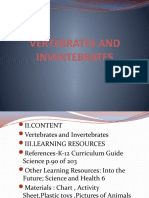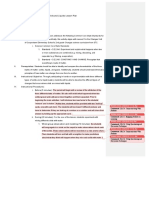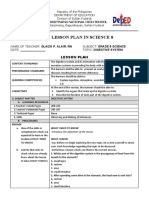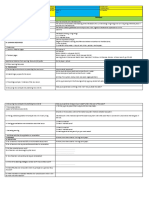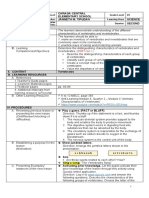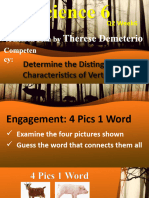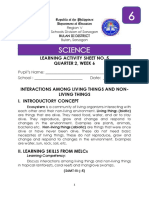Daily Lesson Log in Science 6
Daily Lesson Log in Science 6
Uploaded by
alexander avilaCopyright:
Available Formats
Daily Lesson Log in Science 6
Daily Lesson Log in Science 6
Uploaded by
alexander avilaOriginal Description:
Copyright
Available Formats
Share this document
Did you find this document useful?
Is this content inappropriate?
Copyright:
Available Formats
Daily Lesson Log in Science 6
Daily Lesson Log in Science 6
Uploaded by
alexander avilaCopyright:
Available Formats
Daily Lesson Log in Science 6
VERTEBRATES AND INVERTEBRATES
‘
I. Objectives
A. Content Standards The different characteristics of vertebrates and invertebrates.
B. Performance Standards 1. Make an inventory of vertebrates and invertebrates that
are commonly seen in the community
2. Practice ways of caring and protecting animals
C. Learning Competencies Determine the distinguishing characteristics of vertebrates and
invertebrates. S6MT-IIe-f-3
Knowledge: define vertebrates and invertebrates
Skill: differentiate vertebrates from invertebrates
Attitude: Work collaboratively with the group
II. Content Vertebrates and Invertebrates
III. Learning Resources
A. References
1. Learning Resource Vertebrates and their characteristics
Portal https://lrmds.deped.gov.ph/detail/16226
Invertebrates
https://lrmds.deped.gov.ph/detail/6359
2. Other Learning YouTube Video
resources Vertebrate and invertebrate animals -
Educational videos for kids
https://www.youtube.com/watch?v=Old4GnP8x8Y
Laptop, Projector, PowerPoint Presentation, Activity Sheets
IV. Procedures
A. Reviewing previous (Integration of positive and non-violent discipline)
lesson or presenting the Presenting classroom standards
new lesson 1. Be kind, polite and courteous to others.
2. Keep your hands and feet to yourself
3. Be respectful to everybody
4. Listen to the teacher and classmates, and follow
directions promptly
5. Work hard and do your best.
6. Be safe when handling objects.
7. Raise your hand when you would like to speak in class,
when leaving our seat or when you need to leave the
classroom for certain reasons.
8. Apologize if you make mistakes and strive to do better.
Show the different pictures of animals (refer to the PowerPoint
presentation)
B. Establishing a purpose for (Integration of Vocabulary skills)
the Direction:
lesson/Motivation/Motiv Find the words related to vertebrates and invertebrates. (25
e Question words)
C. Presenting Present/Ask:
examples/instances of Describe the animals below. Can distinguish the similarities and
the lesson differences?
Ask:
1. Which animals have backbones?
2. Which animals have no backbones?
Video Presentation
Vertebrate and invertebrate animals -
Educational videos for kids
https://www.youtube.com/watch?v=Old4GnP8x8Y
Standards in viewing a video presentation
1. Be quiet and stay on your seat when watching the video
2. Remember all the important details shown in the video.
3. Be prepared to share your insights or understanding
about the presented video.
Follow up questions about the video clip presented.
1. What is the video about?
2. What are the different groups of vertebrates?
3. What are the different groups of invertebrates?
D. Discussing new concepts Integration of HOTS and across subject areas
and practicing new skills To further develop the pupils understanding of the concept and
#1 skills, lead them to identify the different characteristics of
vertebrates and invertebrates. Present the chart of vertebrates
and invertebrates.
Say:
1. Which of these animals have backbones?
2. Which of these animals have no backbones?
3. Some animals have no backbones, they are either
softbodied animals or they have an exoskeleton. (unlock
the word exoskeleton)
4. Why are these animals called vertebrates?
5. Why are these animals called invertebrates?
6. Man is an animal by nature, among these 2 classifications
which one are you? Explain why.
E. Discussing new concepts Integration of positive & non-violent discipline and
and practicing new skills differentiated/tiered activity
#2 Group Activity
Directions
1. Group yourselves into four
2. Choose a leader
3. The leader gets the activity sheets and assessment card
form the teacher.
4. Go to your respective area assigned to you.
5. Do the acvity following the group standards
6. Be mindful of the rubrics presented.
7. Finish in ten minutes, and then present your output in
less than 3 minutes.
Rubric in Assessing Group Performance
Description Ratings
1. All members in the
group took part in 1 2 3 4 5
the activity
2. Members agree and
1 2 3 4 5
support each other.
3. Group members
keep on the assigned 1 2 3 4 5
task
4. Group members
practice collaborative 1 2 3 4 5
work
5. Group members
perform well as a 1 2 3 4 5
whole
1 – Major Difficulty 2 – Requires improvement
3 - Good 4 – Very Good 5 – Exemplary
Group 1 – Vertebrates in the community
Directions:
1. Draw all the vertebrates that can be seen in your
community
2. Determine what they do in your community
3. Discuss and share ways on how can you show care for
these animals
Group 2 – Invertebrates in the community
Directions:
1. Draw all the invertebrates that can be seen in your
community
2. Determine what they do in your community
3. Discuss and share ways on how can you show care for
these animals
Group 3 – Comparison
Directions:
1. Draw a pair of vertebrate and invertebrate.
2. Compare their similarities and differences
3. Are they important animals? Explain.
F. Developing Mastery (Integration of Contextualization, Localization and Gender-Fair)
Group Presentation/Reporting
Learners are given utmost recognition in the task they presented
Self-Assessment of the group activity
Each group assesses their own group output rating
G. Finding practical Ask:
applications of concepts 1. Why is it important to keep our bones healthy and
and skills in daily living. strong?
2. Why does a carabao need to have a strong backbone
while an earworm doesn’t?
H. Making generalizations Ask:
and abstractions about 1. What are vertebrates?
the lesson 2. What are invertebrates?
3. How do vertebrates and invertebrates differ from each
other?
4. How can you show care for the animals around you?
5. Why is it important to take care of one’s health?
I. Evaluating Learning
J. Additional activities for Assignment
application or Watch the video based on the link below and write a short
remediation narrative report on what you understood after watching the
video about living things and non-living things.
https://www.youtube.com/watch?v=p51FiPO2_kQ
You might also like
- Detailed Lesson Plan in Science 6 Quarter 2 VertebratesDocument7 pagesDetailed Lesson Plan in Science 6 Quarter 2 VertebratesCid Poniente100% (1)
- BHC RecruitingDocument3 pagesBHC RecruitingFaheem Easa Abdulla MoosaNo ratings yet
- Lesson Plan in ScienceDocument4 pagesLesson Plan in ScienceRHODA ESCOLANONo ratings yet
- Co 1 - 2020-2021Document7 pagesCo 1 - 2020-2021Geraldine A. Andaya100% (1)
- Hidalgo - Co 1 - LP - VertebratesDocument7 pagesHidalgo - Co 1 - LP - VertebratesDennis Aquino100% (8)
- Cot 1 Science 6Document2 pagesCot 1 Science 6HAMPASLUPA TRAVELS75% (4)
- Cot ScienceDocument4 pagesCot Sciencevictor jr. regala100% (2)
- Week 6 Sept.23-26, 2019Document13 pagesWeek 6 Sept.23-26, 2019Heidi Dalyagan DulnagonNo ratings yet
- Lesson Plan in Science 6 Cot 1Document5 pagesLesson Plan in Science 6 Cot 1Nina Grace Joy Marayag0% (1)
- Lesson Plan-4B Writing (Unit 8)Document6 pagesLesson Plan-4B Writing (Unit 8)John Gan100% (1)
- COT - DLP - SCIENCE 6-RESPIRATORY SYStemDocument11 pagesCOT - DLP - SCIENCE 6-RESPIRATORY SYStemFRITZY PREMAYLONNo ratings yet
- Antagan 2Nd Elementary School: (S6MT-ll-f-3)Document3 pagesAntagan 2Nd Elementary School: (S6MT-ll-f-3)Ethelinda Gambol100% (1)
- DETAILED LESSON PLAn in GRADE 4Document6 pagesDETAILED LESSON PLAn in GRADE 4KRISTINE MONTEROLANo ratings yet
- 5e's Lesson Plan in Science 6 (Integumentary System)Document7 pages5e's Lesson Plan in Science 6 (Integumentary System)Shiela Marie EspinoNo ratings yet
- DLL - Science 6 - Q1 - W4Document3 pagesDLL - Science 6 - Q1 - W4Geoffrey Tolentino-UnidaNo ratings yet
- Semi - Detailed Lesson Plan in Science 4, Quarter 2, Week 10 I. ObjectivesDocument3 pagesSemi - Detailed Lesson Plan in Science 4, Quarter 2, Week 10 I. ObjectivesEvaLord Hamot Evangelisan100% (1)
- Vertebrates and InvertebratesDocument14 pagesVertebrates and InvertebratesNj PertimosNo ratings yet
- Mixing Solids and Liquids Lesson Plan AnnotatedDocument3 pagesMixing Solids and Liquids Lesson Plan Annotatedapi-443642124No ratings yet
- Lesson Plan in PE & HEALTH.Document10 pagesLesson Plan in PE & HEALTH.lorena marinasNo ratings yet
- Lesson Plan Science 5Document9 pagesLesson Plan Science 5Marj Reña LunaNo ratings yet
- Arvin Tocino Lesson Plan For Grade 6 ScienceDocument4 pagesArvin Tocino Lesson Plan For Grade 6 Sciencearvin tocinoNo ratings yet
- A Detailed Lesson Plan in ScienceDocument8 pagesA Detailed Lesson Plan in Sciencedeseree abendanio100% (1)
- Lesson Plan in ScienceDocument8 pagesLesson Plan in Sciencekai abuevaNo ratings yet
- Lesson PlanDocument5 pagesLesson PlanJerald LinogonNo ratings yet
- Science 6 q1 Cot Separating MixturesDocument7 pagesScience 6 q1 Cot Separating MixturesLeilani Nipal100% (1)
- DLL - Science 6 - Q1 - W7Document4 pagesDLL - Science 6 - Q1 - W7Geoffrey Tolentino-Unida100% (1)
- Science-G6q1w3l4-Classification of ColloidsDocument11 pagesScience-G6q1w3l4-Classification of ColloidsJeson Palomares100% (1)
- Cot Lesson Plan in Science 6, 2nd Gradimg.Document8 pagesCot Lesson Plan in Science 6, 2nd Gradimg.princess nicole lugtuNo ratings yet
- Science 6 Lesson 28 COT1Document3 pagesScience 6 Lesson 28 COT1Rachelle Bernabe100% (2)
- Eunice M. Tunacao LP VertebratesDocument12 pagesEunice M. Tunacao LP VertebratesEunice TuñacaoNo ratings yet
- Lesson Plan Digestive SystemDocument5 pagesLesson Plan Digestive SystemglaizaNo ratings yet
- A Lesson Plan in Science VI Demo TeachingDocument5 pagesA Lesson Plan in Science VI Demo TeachingMelita HernandezNo ratings yet
- DLP Science 6 Q2 W2 Day 5Document5 pagesDLP Science 6 Q2 W2 Day 5Rubie Jane Aranda100% (1)
- Lesson Exemplar in Science 6Document7 pagesLesson Exemplar in Science 6Madona ParallagNo ratings yet
- DLL - Science 6 - Q2 - W7Document10 pagesDLL - Science 6 - Q2 - W7Geoffrey Tolentino-Unida100% (2)
- Caraga Central Elementary School VI Janneth M. Tipudan Science Second I. Objectives A. Content Standard B. Performance StandardsDocument5 pagesCaraga Central Elementary School VI Janneth M. Tipudan Science Second I. Objectives A. Content Standard B. Performance StandardsRey Abdon IbañezNo ratings yet
- DAILY LESSON PLAN Science 6Document6 pagesDAILY LESSON PLAN Science 6judyannmaranancortez0927100% (1)
- How Friction Affect Movement of Objects SemiDocument5 pagesHow Friction Affect Movement of Objects SemiPatrick kenneth GacayanNo ratings yet
- Quarter 1 Week 8Document3 pagesQuarter 1 Week 8Geoffrey Tolentino-UnidaNo ratings yet
- 6rd Lesson Plan Vertebrates and Invertebrates RDocument2 pages6rd Lesson Plan Vertebrates and Invertebrates Rapi-30114230475% (4)
- Lesson Plan in Science 5-Quarter 2Document7 pagesLesson Plan in Science 5-Quarter 2Mawe NibredaNo ratings yet
- SCIENCE6Q1MELC2Document35 pagesSCIENCE6Q1MELC2Elsa VergaraNo ratings yet
- A LESSON PLAN in SCIENCE 6 Vertebrates and InvertebratesDocument6 pagesA LESSON PLAN in SCIENCE 6 Vertebrates and InvertebratesAbba Joy100% (2)
- Lesson Plan Sci 6Document8 pagesLesson Plan Sci 6Mary Grace Nicos MagsucangNo ratings yet
- DLP Science 6 - q1 WK 4 Day 1Document7 pagesDLP Science 6 - q1 WK 4 Day 1Sonny MatiasNo ratings yet
- Lesson Plan in Science - EcosystemDocument10 pagesLesson Plan in Science - Ecosystemchristinejem.geligNo ratings yet
- COT 1 Interaction Among Living Things and Non Living Things in Tropical Rainforest NewDocument9 pagesCOT 1 Interaction Among Living Things and Non Living Things in Tropical Rainforest NewTrisha GonzalesNo ratings yet
- Cot DLP Science 6 Q4 Week 2 Judith D. SunicoDocument9 pagesCot DLP Science 6 Q4 Week 2 Judith D. SunicoEloisa Binuya100% (2)
- Lesson Plan in ScienceDocument14 pagesLesson Plan in ScienceRuby C. Delos SantosNo ratings yet
- Lesson Plan COT1Document8 pagesLesson Plan COT1lea mae bayaNo ratings yet
- Science 6 Quarter 3 Module 1 Week 1 Friction Let's UnderstandDocument4 pagesScience 6 Quarter 3 Module 1 Week 1 Friction Let's UnderstandALLYSSA MAE PELONIANo ratings yet
- DLP Sci-4 q2 Wk1 Day-1Document6 pagesDLP Sci-4 q2 Wk1 Day-1Mayen FatimaNo ratings yet
- Lesson Plan About InvertebratesDocument3 pagesLesson Plan About Invertebratessaima100% (2)
- Separation Techniques For Mixtures 5 E S Lesson PlanDocument9 pagesSeparation Techniques For Mixtures 5 E S Lesson PlanEdgar Miralles Inales Manriquez100% (1)
- Science6 Q2 - Lesson On Determine The Distinguishing Characteristics of VertebratesDocument50 pagesScience6 Q2 - Lesson On Determine The Distinguishing Characteristics of VertebratesMaria Theresa DemeterioNo ratings yet
- Cot (2) Science Earth's RotationDocument8 pagesCot (2) Science Earth's RotationJanie Mae Estrada Pelien75% (4)
- Las Sci6 Q2 Week6Document9 pagesLas Sci6 Q2 Week6Gianna Baldorado100% (1)
- COT 2 - Science 6 - Q4Document7 pagesCOT 2 - Science 6 - Q4Benedic ColladoNo ratings yet
- 1st Quarter COT Q2 Week 1 Skeletal SystemDocument10 pages1st Quarter COT Q2 Week 1 Skeletal SystemJazzjanz RugaNo ratings yet
- DepEd Lesson Plan Format in ScienceDocument9 pagesDepEd Lesson Plan Format in ScienceChenie GregoreNo ratings yet
- Lesson Plan in Science 6Document6 pagesLesson Plan in Science 6Cristian Odchigue NartiaNo ratings yet
- Dear Future SelfDocument6 pagesDear Future SelfJames Melo-Gurny BobbyNo ratings yet
- Learning Strategies in English Language Acquisition and English Language TeachingDocument10 pagesLearning Strategies in English Language Acquisition and English Language TeachingHường NguyễnNo ratings yet
- DeRomanis FAQs 1Document5 pagesDeRomanis FAQs 1alópez_199227No ratings yet
- Part 1 Genre AnalysisDocument16 pagesPart 1 Genre AnalysisdanizaNo ratings yet
- New Brighton School of The Philippines: Pres. Ramon Magsaysay Ave, General Santos CityDocument6 pagesNew Brighton School of The Philippines: Pres. Ramon Magsaysay Ave, General Santos CityJofranco Gamutan LozanoNo ratings yet
- The Taba Tyler RationalesDocument12 pagesThe Taba Tyler RationalesCatherine AbergosNo ratings yet
- WHY Class?: Exploring The Promise of The Classroom Assessment Scoring System® (CLASS)Document22 pagesWHY Class?: Exploring The Promise of The Classroom Assessment Scoring System® (CLASS)sarumaniNo ratings yet
- Ipdp 2018 2019Document2 pagesIpdp 2018 2019Joel Hinay100% (1)
- ICE Task 1 Example Grade R Life Skills Movement Activity Plan Template WordDocument7 pagesICE Task 1 Example Grade R Life Skills Movement Activity Plan Template Wordnafeesah lagardienNo ratings yet
- Learning To Live Together Discussion PaperDocument25 pagesLearning To Live Together Discussion PaperPEIC Data100% (2)
- Ank 061Document3 pagesAnk 061amir kunwarNo ratings yet
- Mrs. Benson's Homework April 7 - April 11, 2014: TH THDocument2 pagesMrs. Benson's Homework April 7 - April 11, 2014: TH THGretchen BensonNo ratings yet
- 5.2 - System Analysis and DesignDocument19 pages5.2 - System Analysis and DesignPiyush SinghNo ratings yet
- She Is A Born Leader (Autosaved)Document54 pagesShe Is A Born Leader (Autosaved)tutyafiatun32No ratings yet
- Party Invitation RubricDocument1 pageParty Invitation Rubricapi-2872143410% (1)
- Moral Decision-MakingDocument2 pagesMoral Decision-MakingYousef KhalifaNo ratings yet
- CV 2020Document3 pagesCV 2020claudetteNo ratings yet
- Presentation On PhilosophiesDocument17 pagesPresentation On Philosophiestheressa reidNo ratings yet
- Maslow's Hierarchy of Needs - Wikipedia PDFDocument23 pagesMaslow's Hierarchy of Needs - Wikipedia PDFNikhila Reddy PuttaNo ratings yet
- GTM & DMDocument5 pagesGTM & DMShinta Ari HerdianaNo ratings yet
- Changing Health Behaviour PDFDocument33 pagesChanging Health Behaviour PDFvpapaefNo ratings yet
- Discourse AnalysisDocument14 pagesDiscourse AnalysisZimbra MigrationNo ratings yet
- Lecture 2 - Methods of Performance AppraisalDocument47 pagesLecture 2 - Methods of Performance Appraisalmaiesha tabassumNo ratings yet
- The American Dream ProjectDocument2 pagesThe American Dream ProjectJessicaNo ratings yet
- Example of A Thesis Statement For A Reflective EssayDocument7 pagesExample of A Thesis Statement For A Reflective Essaykmxrffugg100% (1)
- Scheme of Work First Language EnglishDocument9 pagesScheme of Work First Language EnglishBEY ONGNo ratings yet
- Sample Technical DocumentationDocument5 pagesSample Technical DocumentationPupsikNo ratings yet
- Physical Fitness, Gymnastics and AerobicsDocument5 pagesPhysical Fitness, Gymnastics and AerobicsJannah Mariz ChengNo ratings yet
- Powerpoint Project "All About Me": Requirements For The PresentationDocument2 pagesPowerpoint Project "All About Me": Requirements For The PresentationJIM GUIMAC100% (1)
















